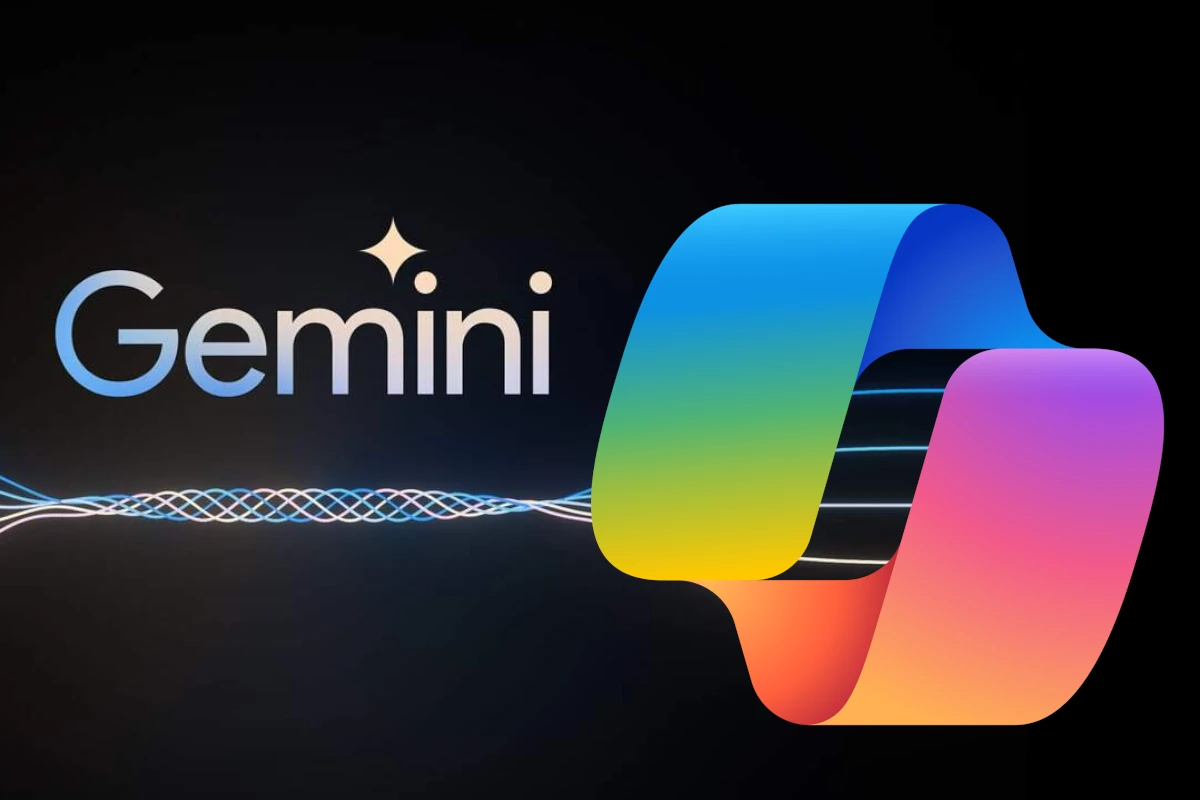Microsoft Copilot and Google Gemini seem very similar at first glance and their interfaces and functionality are alike, but there are some key differences between them that you should be aware of. Both are powerful AI assistants that make tasks easier and more efficient. Google’s Gemini allows long conversations, while Copilot is limited to five replies in one conversation. It’s essential to note that Google Gemini is more consumer-oriented, while Copilot is more focused on business services. Some (especially business users) might prefer to use something like Copilot, while others (consumers/home users) might perfer Gemini or ChatGPT for various tasks.
Despite Google’s headstart in AI, Microsoft’s dominance in business services remains strong. It will be interesting to see how these platforms evolve over time.
Google Gemini vs. Microsoft Copilot
| Feature | Google Gemini | Microsoft Copilot |
|---|---|---|
| Core Technology | Large Language Model (LLM) developed by Google AI | Large Language Model (LLM) powered by OpenAI’s GPT-4 |
| Integration | Integrated into Google Workspace apps (Docs, Sheets, Slides, etc.) and other Google services | Integrated into Microsoft 365 apps (Word, Excel, PowerPoint, etc.) and other Microsoft services |
| Key Features | Text generation (writing emails, documents, code) Summarization and translation Image generation and editing Data analysis and visualization | Text generation (writing emails, documents, code) Summarization and translation Data analysis and visualization Workflow automation (creating presentations, scheduling meetings) |
| Strengths | Strong text and image generation capabilities Seamless integration with Google Workspace Focus on creative content generation | Deep integration with Microsoft 365 Stronger focus on productivity and workflow automation Wider range of applications within the Microsoft ecosystem |
| Weaknesses | Limited functionality in some Google Workspace apps Less mature in terms of workflow automation Image generation capabilities still under development | Less emphasis on creative content generation Can sometimes generate inaccurate or irrelevant information Reliance on OpenAI’s technology |
| Pricing | $30 per user per month (as part of Google Workspace) | $30 per user per month (as part of Microsoft 365) |
AI Assistants: Understanding the Differences
Focus and Strengths
- Google Gemini: Gemini excels at creative text generation and understanding complex questions. It’s often used within Google Docs to improve writing, offer suggestions, and even write full pieces of content.
- Microsoft Copilot: Copilot integrates tightly with Microsoft 365 apps. It helps you write better emails in Outlook, create presentations in PowerPoint, or analyze data in Excel.
Features and Capabilities
Here’s a table outlining the main features of each AI tool:
| Feature | Google Gemini | Microsoft Copilot |
|---|---|---|
| Text generation | Yes | Yes |
| Summarizing text | Yes | Yes |
| Answering questions | Yes | Yes |
| Translating languages | Yes | Limited |
| Coding suggestions | Limited | Yes |
| Creating presentations | Limited | Yes |
Where to Use Them
- Google Gemini: Best used within Google’s ecosystem, primarily in Google Docs and Google Workspace apps.
- Microsoft Copilot: Ideal for those heavily invested in the Microsoft 365 suite of products.
The Bottom Line
Both Google Gemini and Microsoft Copilot are impressive AI assistants offering distinct advantages. The best choice for you depends on your primary productivity tools and the kinds of tasks you want to streamline.
Comparative Analysis of Google Gemini and Microsoft Copilot
In the face of rapidly evolving AI technologies, Google Gemini and Microsoft Copilot stand out as top contenders in the artificial intelligence assistant market. Here, we will explore how these tools stack up against each other in terms of their underlying tech, features, and multimodal capabilities.
Core Technologies and AI Tools
Google Gemini, built on the foundation of Google’s machine learning expertise, features the powerful Gemini Ultra AI, which excels in natural language processing and understanding context. Its ability to score highly on the MiniTuring multimodal language understanding, or MMLU, benchmark indicates its superior reasoning capabilities across various types of data. It integrates seamlessly with Google Workspace, bringing AI to a suite of tools many already use.
Microsoft Copilot, on the other hand, draws from the capabilities of GPT-3 and GPT-4, which are known for their human-like text generation and coding skills. It shines within the Microsoft 365 ecosystem, enhancing productivity by leveraging context to assist with tasks across Word, Excel, Outlook, and other applications. Windows 11 users find it particularly adept at handling an array of desktop functions.
Capabilities and Features
With Gemini Ultra at its core, Google Gemini offers users two versions: the free and the premium Gemini Pro. The Pro version extends the AI’s capabilities, allowing it to tackle more complex tasks that demand a deeper understanding and sophisticated analysis. Microsoft Copilot, through its integration with Microsoft 365, provides users with an AI assistant that can assist with not just content creation but also data analysis and software coding.
Both AI assistants facilitate collaboration among users. Google’s approach aims for broader inclusivity by embedding its AI in commonly used tools, while Microsoft’s Copilot targets professionals seeking a deeply integrated experience within their existing workflow.
Multimodal Functions and Applications
Multimodal functions in AI refer to the ability to process and understand various forms of media – text, images, video, and audio. Gemini AI’s proficiency in the multimodal domain is evident in its performance across benchmarks. These skills are particularly useful in deciphering the context from multiple data types and providing relevant assistance or insights.
Microsoft’s Copilot brings multimodal capabilities into play by enabling users to generate code, automate tasks, and create content that combines text with data pulled from spreadsheets or emails. Its strength lies in its adaptability and the way it streamlines the creative and technical processes, which is particularly beneficial for users working in fields like software development and content creation.
Implementation and Integration
This section examines how Google Gemini and Microsoft Copilot are incorporated into various environments and how they enhance the workflow within those spaces.
Developers and Coding Platforms
Google Gemini: Implementation of Google Gemini largely involves Google Cloud services and its API can be integrated into coding platforms. With the introduction of Gemini Nano, developers can leverage AI in applications that require subtler, less resource-intensive models. Google’s AI ecosystem also includes tools such as Vertex AI, which simplifies the process of deploying and maintaining AI models.
Microsoft Copilot: On the other side, Microsoft presents Copilot with native integration into Visual Studio Code and GitHub. This allows developers to use AI-assisted coding directly within their familiar development environments. Microsoft’s Lambda architecture enables processing of vast amounts of data, useful for foundation models that learn from GitHub’s codebase.
Business and Productivity Tools
Google’s Suite: Google has seamlessly connected Gemini with well-known productivity tools like Google Docs, Sheets, Slides, Gmail, and Google Calendar. The integration facilitates tasks such as drafting documents, managing emails, and scheduling, all with the assistance of AI technology.
Microsoft 365 Tools: Similarly, Copilot is embedded in Microsoft’s suite of tools including Word, Excel, PowerPoint, Teams, and Outlook. This integration streamlines business operations, fostering a productive and collaborative workplace.
AI-Powered Creative and Analytical Tasks
Google and Microsoft extend their AI offering to include support for creative and analytical tasks. For example:
- Translation and Question Answering: Google’s AI excels in translation and complex question-answering engagements, likely thanks to projects like Bard Advanced and contributions from teams led by figures such as Sissie Hsiao.
- Content Creation: Microsoft capitalizes on AI-powered content creation, supported by their collaboration with OpenAI and the integration of ChatGPT-like capabilities into user interfaces.
Ethical Considerations and Market Impact
In the growing rivalry between Microsoft Copilot and Google Gemini, ethical use and market dynamics play pivotal roles. The way these AI services affect both users and competition sheds light on their future in the tech community.
AI Bias and Ethical Use
Bias: Both Microsoft Copilot and Google Gemini have the potential for AI bias, which could lead to skewed results in tasks like content generation or coding suggestions. It’s important for developers to rigorously test these systems to ensure fairness and accuracy. For instance, Google has committed resources to address concerns regarding AI bias, particularly with its release of products like the Pixel 8 Pro, which may incorporate AI elements.
Ethical Use: Using AI ethically ensures that it augments human intelligence without replacing it, particularly in sensitive areas such as scheduling or collaboration. Both companies have outlined ethical guidelines, but practical implementation is crucial. For example, the way DALL-E is used to generate images raises questions about creative ownership that both Microsoft and Google must consider when developing similar AI tools.
Competitive Landscape
Pricing: With different tiers like Gemini Ultra and Copilot Pro, the companies are targeting various market segments, from casual users of services like ChatGPT to professional developers and large enterprises.
Ecosystem and Collaboration: Microsoft and Google are leveraging their respective ecosystems — Microsoft 365 and Google Workspace — to create seamless experiences. As echoed by Sundar Pichai, the integration of AI into products must be intuitive. Microsoft’s infusion of AI into cornerstone applications like Word and PowerPoint exemplifies their strategy to maintain a competitive edge.
Market Influence: The introduction of AI services has significant market repercussions. While Microsoft relies on its strong existing user base, Google aims to expand its influence in the smartphone market with AI-integrated features in Pixel phones. This competition encourages both tech giants to continually improve their AI offerings, shaping the landscape of modern technology.
Frequently Asked Questions
In this part, we’ll look at some common questions about the two AI tools, Google Gemini and Microsoft Copilot, focusing on their strengths, weaknesses, and unique features.
What are the advantages and disadvantages of Google Gemini compared to Microsoft Copilot?
Google Gemini boasts impressive language understanding capabilities, outperforming others on numerous benchmarks. However, it may fall short in integrating with Microsoft-centric workflows where Copilot excels, such as seamless operation within Microsoft 365’s ecosystem.
How does Google Bard’s capabilities compare to ChatGPT and Microsoft Copilot?
Google Bard was seen as a direct response to ChatGPT, with similar conversational abilities. While Microsoft Copilot leverages the Bing search engine for informational queries, Bard aimed to integrate with Google’s vast search abilities but was eventually succeeded by Gemini.
Which is more sophisticated in terms of technology, Bard or GPT-4, and what are the implications?
Technology-wise, Bard was Google’s effort at an AI service, but it lacked the refinement and adoption compared to OpenAI’s GPT-4, known for its advanced conversational skills. However, Google’s Gemini is now positioned to compete more directly with the capabilities of GPT-4.
What distinguishes Google’s Gemini from Bard in terms of functionality and use cases?
Gemini has surpassed Bard, especially after achieving higher performance scores on language understanding benchmarks. It’s tailored for both general use and specialized tasks, offering a broader spectrum of functionalities beyond just conversational AI.
How can users access and utilize Google Gemini’s features?
Google Gemini is accessible through Google’s platforms and offers a paid version for enhanced capabilities. Users can interact with it for a variety of tasks, from daily inquiries to complex problem-solving scenarios.
In what scenarios might Microsoft Copilot be more beneficial to use than Google Gemini or Bard?
Microsoft Copilot shines in environments that heavily rely on Microsoft products. It’s designed to integrate with Microsoft 365, making it an excellent choice for businesses and individuals deeply rooted in Microsoft’s suite of services.







